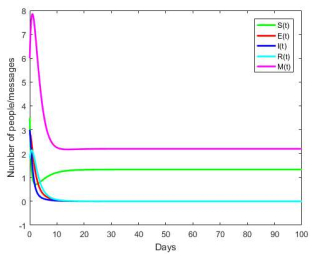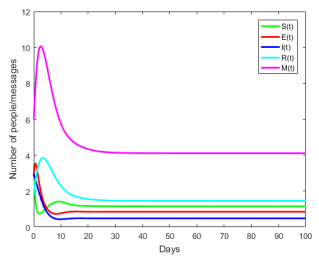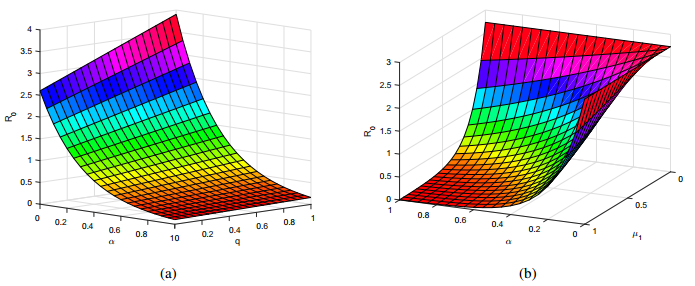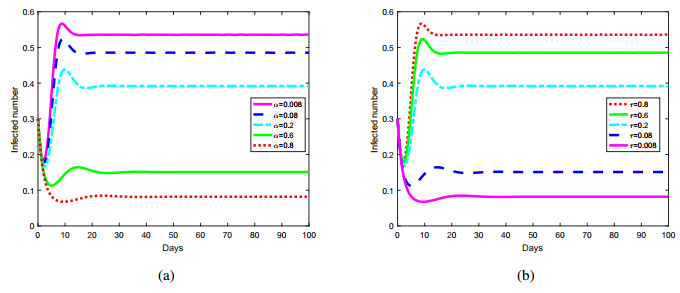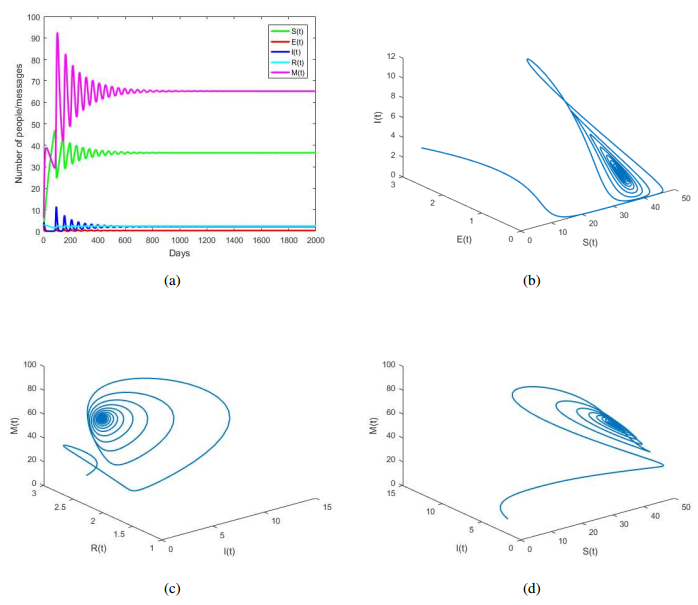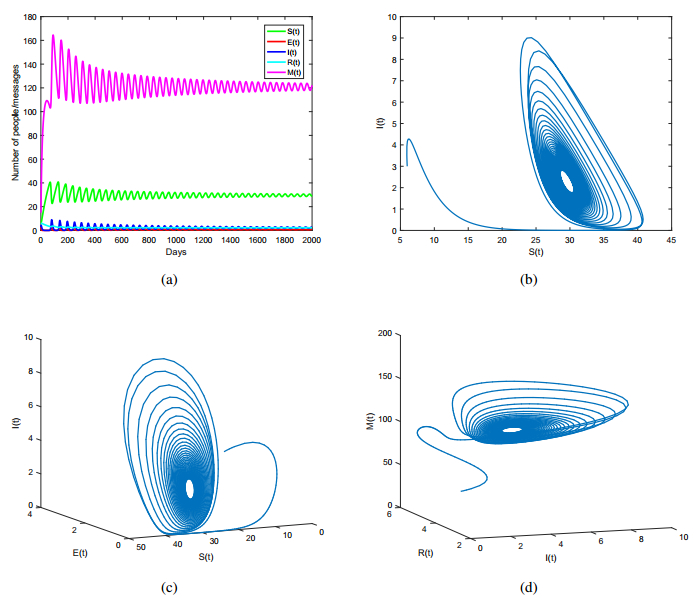1.
Introduction
Tuberculosis (TB) is a common and fatal infectious disease. It has become a chronic infectious disease that threatens human health worldwide. Globally, in 2016 there were an estimated 10.4 million incident cases of TB, equivalent to 140 cases per 100000 population. Meanwhile, the proportion of people who develop TB and die from the disease (the case fatality ratio) was 16 [1]. Therefore, TB has become a global concern for social and public health issues.
Many scholars have carried out a lot of excellent researches on the transmission mechanism and prevention strategies of TB [2,3,4,5,6]. Silva et al. [4] introduced delays in a TB model, and studied optimal control of TB with state and control delays. Huo et al. [5] presented a two-strain TB model with general contact rate which allows TB patients with the drug sensitive of strain Mycobacterium tuberculosis to be treated and gave a detailed qualitative analysis about positivity, boundedness, existence, uniqueness and global stability of the equilibria of the model. Huo and Zou [6] studied a TB model with two kinds of treatment, that is, treatment at home and treatment in hospital and showed that the treatment at home has a negative influence on the spread of TB.
The susceptible individuals who carry the pathogen developing into infectious individuals are different from the progression of TB transmission. Some people may become symptomatic infectious individuals after a few days or months, and some people may occur after several years or even decades. For the former, it is considered that the susceptible individuals directly develop symptomatic infectious individuals without going through the latency period after infection, which is called the fast progression of TB transmission. For the latter, it is considered that the susceptible individuals become the latent individuals carrying the pathogen after infection with Mycobacterium tuberculosis, and they can become infected by exogenous reinfection or endogenous infection, which is called a slow progression of TB transmission. Huo and Feng [7] constructed an HIV/AIDS epidemic model with different latent stages and treatment. The model allowed for the latent individuals to have the fast and slow latent compartments. Mccluskey [8] introduced the spread of TB through two models which included fast and slow progression to the infected class. Berge et al. [9] considered a two patch cholera model with the aim of investigating the impact of human population movements between two cities(patches). Song et al. [10] studied TB models with fast and slow dynamics. Many scholars have studied infectious diseases related to the fast and slow progression (see e.g. [11] and references cited therein).
Media coverage is changing the way that we communicate with each other in our daily life, work and study. The media may be the most important source of public health information. At the same time, it also plays an important role in the spread and control of epidemics by providing some health information. Cui et al. [12] proposed a general contact rate β(I)=c1−c2f(I) to reflect some intrinsic characters of media coverage. Huo and Zhang [13] introduced a novel alcoholism model which involves impact of Twitter, and showed that Twitter can serve as a good indicator of alcoholism model and affect the spread of the drinking. Huo et al. [14] presented a SEIS epidemic model with the impact of media coverage. Their results manifested that media can be regarded as a good indicator in controlling the emergence and spread of the epidemic disease. Many scholars have done a lot of researches on infectious diseases with or without media coverage [15,16,17,18,19,20,21].
Motivated by the above, we construct a new TB model which not only involves fast and slow progression but also incorporates the impact of media coverage in this paper. We study the stability of all the equilibria. Furthermore, we also investigate the occurrence of backward and forward bifurcation. Our results show that media coverage can encourage people to take countermeasures to avoid potential infections.
The rest of this paper is organized as follows. In Section 2, a new tuberculosis model with fast and slow progression and media coverage is constructed. In Section 3, we discuss the existence and stability of all the equilibria, then we analyze a forward and backward bifurcation. Some numerical simulations are presented in Section 4. Sensitivity analysis and some discussions are given in the last section.
2.
Model formulation
2.1. System description
The total population N(t) is divided into four compartments: S(t), E(t), I(t) and R(t). S(t) denotes susceptible individuals. E(t) is referred to as undetected non-symptomatic (latent) carriers. I(t) is symptomatic infectious individuals. R(t) represents recovered individuals. M(t) represents the number of message that all of them provide about TB at time t. The total population N(t) is given by
The transfer diagram of the model is shown in Figure 1. The transfer diagram leads to the following system of ordinary differential equations:
All the parameters are positive constants. δ is the constant recruitment rate of the population. β is the transmission coefficient of TB. α is the coefficient that determines how effective the disease-related messages can influence the transmission rate and the transmission rate β is reduced by a factor e−αM (see [13,14]). μ is the natural death rate. q is the proportion of disease by fast progression. ε is the progression rate from the exposed individuals to the infected individuals. d is the disease-related death rate of TB. γ is the recovery rate of TB. τ is the rate that message become outdated. μ1, μ2, μ3 and μ4 are the rates that susceptible individuals, exposed individuals, infectious individuals, recovered individuals may send messages about TB, respectively.
2.2. Basic properties
In this section, we will show positivity and boundedness for system (2.1).
2.2.1. Positivity of solutions
Lemma 1. If S(0)≥0,E(0)≥0,I(0)≥0,R(0)≥0,M(0)≥0, the solutions S(t), E(t), I(t), R(t), M(t) of system (2.1) are positive for all t>0.
Proof. If S(0)≥0, according to the first equation of system (2.1), we have
It can be rewritten as:
Therefore,
Hence,
So,
Similarly, we can show that E(t)>0,I(t)>0,R(t)>0,M(t)>0. So the solutions S(t), E(t), I(t), R(t), M(t) of system (2.1) with initial conditions S(0)≥0,E(0)≥0,I(0)≥0,R(0)≥0,M(0)≥0 are positive for all t>0. This completes the proof of Lemma 1.
2.2.2. Invariant region
Lemma 2. The feasible region Ω defined by
with initial conditions S(0)≥0,E(0)≥0,I(0)≥0,R(0)≥0,M(0)≥0 is positively invariant for system (2.1).
Proof. Adding the former four equations of system (2.1), we obtain
It follows that
where N(0) is the initial value of total number of people. Thus,
Then
Further, from the last equation of system (2.1), we have
It follows that
where M(0) represents the initial value of cumulative density media coverage. Thus,
It implies that the region
is a positively invariant set for system (2.1). So we consider dynamics of system (2.1) on the set Ω in this paper. This completes the proof of Lemma 2.
3.
Analysis of the model
3.1. The basic reproductive number
It is easy to see system (2.1) always has a disease-free equilibrium
We can obtain the basic reproductive number R0 by using the next-generation method [22]. Let x=(E,I,R,S,M)T, then system (2.1) can be written as
where,
The Jacobian matrices of F(x) and V(x) at the disease-free equilibrium P0 are, respectively,
where
The basic reproductive number, denoted by R0 is thus given by
3.2. Stability of disease-free equilibrium
Theorem 1. The disease-free equilibrium P0=(δμ,0,0,0,μ1δμτ) of system (2.1) is locally asymptotically stable if R0<1, and is unstable if R0>1.
Proof. The Jacobian matrix corresponding to system (2.1) about P0=(δμ,0,0,0,μ1δμτ) is obtained as follows:
The characteristic equation corresponding to the Jacobian matrix J(P0) is given by |λE−J(P0)|=0, where λ is the eigenvalue and E is the unit matrix. Thus, we get
Obviously, Eq. (3.3) has three negative roots λ1=−τ, λ2=λ3=−μ, and the other two roots λ4 and λ5 are determined by
According to the above calculation and analysis, we can obtain
If R0<1, we have λ4λ5>0, λ4+λ5<0, hence λ4<0,λ5<0. Therefore, P0=(δμ,0,0,0,μ1δμτ) is locally asymptotically stable. If R0>1, Eq. (3.4) has two real roots that one is positive and another is negative. In this case, P0=(δμ,0,0,0,μ1δμτ) is unstable. This completes the proof of Theorem 1.
Theorem 2. The disease-free equilibrium P0=(δμ,0,0,0,μ1δμτ) of the system (2.1) is globally asymptotically stable if R0<1 and M(t)≥μ1δμτ.
Proof. Motivated by Huo and Zhang [13], we define the Lyapunov function
It is clear that V(t)≥0 and the equality holds if and only if E(t)=I(t)=0.
From the first equation of the system (2.1), we have
and then we can obtain S(t)≤δμ.
Differentiating V(t) with respect to time t yields:
It follows that V(t) is bounded and non-increasing. Therefore, limt→∞V(t) exists. Note that dV(t)dt=0 if and only if E=I=R=0,S=S0=δμ,M=M0=μ1δμτ. The maximum invariant set of the system (2.1) on the set {(S,E,I,R,M):dV(t)dt=0} is the singleton P0=(δμ,0,0,0,μ1δμτ). And note that R0<1 guarantees that dV(t)dt≤0 for all t≥0. By LaSalle's Invariance Principle [23], the disease-free equilibrium P0=(δμ,0,0,0,μ1δμτ) is globally asymptotically stable when R0<1 and M(t)≥μ1δμτ. This completes the proof of Theorem 2.
3.3. Existence and Stability of the endemic equilibria
First, we introduce:
Remark 1. It is clear to check that: R01>0 if and only if Φ>0; R01=0 if and only if Φ=0; R01<0 if and only if Φ<0.
Theorem 3. For system (2.1),
(ⅰ) If R0>max{1,R01}, there is a unique endemic equilibrium P∗1.
(ⅱ) If Rc=R0<min{1,R01} and R01>0, there is a unique endemic equilibrium P∗2.
(ⅲ) If Rc<R0<min{1,R01} and R01>0, there are two distinct endemic equilibria P∗3 and P∗4.
Proof. The endemic equilibrium P∗(S∗,E∗,I∗,R∗,M∗) of system (2.1) is determined by equations
Further, we obtain
where Φ is given by (3.5). Substituting S,M into the first equation of (3.8) yields
According to (3.6) and (3.13), we have
We consider a function F(I) defined by
Then, we have
Case 1. When Φ=0, according to (3.13), we have
Therefore, there is a unique endemic equilibrium if Φ=0 and R0>1.
Case 2. When Φ≠0, we have
Thus, we get F′(I)<F′(0), which means Φe−ΦI<Φ.
(1) If R0>1, we have F(0)=R0−1>0, F(+∞)=−∞<0, and
When R0>R01>0, we have Φ>0 and 1−R0R01<0, which means F′(I)<0.
When R0>0>R01, we have Φ<0 and 1−R0R01>0, which means F′(I)<0.
Therefore, there is a unique endemic equilibrium if Φ≠0 and R0>max{1,R01}.
In conclusion, there is a unique endemic equilibrium P∗1 if R0>max{1,R01}.
(2) If R0<1, we have F(0)=R0−1<0, F(+∞)=−∞<0, Let's suppose
Then we obtain
When R0<R01, we have Φ>0 and lnR01R0>0, which means Ic>0.
Substituting Ic into (3.14), we get
(a) When F(Ic)=0, we can obtain I∗2=Ic and R0=Rc, where Rc is given by (3.7).
Therefore, there is a unique endemic equilibrium P∗2 if Rc=R0<min{1,R01} and R01>0.
(b) When F(Ic)>0, we can obtain R0>Rc.
Since F(0)=R0−1<0, F(+∞)=−∞<0 and F(Ic)>0, we know that F(I)=0 has two different positive solutions I∗3 and I∗4. Let I∗3 and I∗4 satisfy I∗3<I∗2<I∗4. Therefore, there are two distinct endemic equilibria P∗3 and P∗4 if Rc<R0<min{1,R01} and R01>0. This completes the proof of Theorem 3.
Theorem 4. When q=0, the endemic equilibria P∗i(i=1,2,3,4) of system (2.1) have the following qualities:
(ⅰ) If R0>max{1,R01}, a1(I∗1)a2(I∗1)−a3(I∗1)>0, a3(I∗1)[a1(I∗1)a2(I∗1)−a3(I∗1)]−[a1(I∗1)]2a4(I∗1)>0 and a4(I∗1)>0, the endemic equilibrium P∗1 is locally asymptotically stable.
(ⅱ) If Rc=R0<min{1,R01} and R01>0, the endemic equilibrium P∗2 is unstable.
(ⅲ) If Rc<R0<min{1,R01} and R01>0, the endemic equilibrium P∗3 is unstable.
(ⅳ) If Rc<R0<min{1,R01} and R01>0, the stability of the endemic equilibrium P∗4 is uncertain.
Proof. When q=0, the Jacobian matrix corresponding to system (2.1) about P∗i(i=1,2,3,4) are obtained as follows:
The characteristic equation corresponding to the Jacobian matrix J(P∗i) is given by |λE−J(P∗i)|=0, where λ is the eigenvalue and E is the unit matrix. Thus, we get
We set Θ=βe−αM∗i, then
From the second equation of (3.8), we have
then
and
Therefore, the characteristic equation can be rewritten as:
where
where
(ⅰ) According to (3.17)-(3.20), we have
It is clear that a1(I∗1)>0, according to Routh−Hurwitz criteria [24], the proof (ⅰ) of Theorem 4 is obtained.
(ⅱ) According to the proof of (ⅱ) of Theorem 3, we have I∗2=1ΦlnR01R0. Then, we can get ΘI∗2=μΦI∗2. Therefore, based on (3.17)-(3.20), we can obtain
It is easy to know that a3(I∗2)≠0, and a1(I∗2)a2(I∗2)−a3(I∗2)<0. Therefore, we know that Eq. (3.15) has negative, positive and zero eigenvalues. So the endemic equilibrium P∗2 of system (2.1) is unstable.
(ⅲ) Due to I∗3<I∗2=1ΦlnR01R0, we can get ΘI∗3<μΦI∗3. Therefore, based on (3.17)-(3.20), we can obtain
and
Let gj(I∗3)(j=1,2,3,4) be the solutions of F(λ)=0, and we assume that the real parts satisfy Re(g1(I∗3))≤Re(g2(I∗3))≤Re(g3(I∗3))≤Re(g4(I∗3)), where Re means the real part of a complex number. Then we can obtain gj(I∗3)(j=1,2,3,4) satisfying
and
So, we have Re(g1(I∗3))<0 and Re(g4(I∗3))>0. Then, we know that the endemic equilibrium P∗3 of system (2.1) is unstable.
(ⅳ) Due to I∗4>I∗2=1ΦlnR01R0, we have ΘI∗4>μΦI∗4. Therefore, based on (3.17)-(3.20), we can obtain
and
Let gj(I∗4)(j=1,2,3,4) be the solutions of F(λ)=0, and we assume that the real parts satisfy Re(g1(I∗4))≤Re(g2(I∗4))≤Re(g3(I∗4))≤Re(g4(I∗4)). Then we can obtain gj(I∗4)(j=1,2,3,4) satisfying
and
Therefore, if Re(gj(I∗4))<0(j=1,2,3,4), the endemic equilibrium P∗4 of system (2.1) is stable. However, if Re(g1(I∗4))≤Re(g2(I∗4))<0<Re(g3(I∗4))≤Re(g4(I∗4)) and |Re(g1(I∗4))|+|Re(g2(I∗4))|>|Re(g3(I∗4))|+|Re(g4(I∗4))|, the endemic equilibrium P∗4 of system (2.1) is unstable. Thus, the stability of the endemic equilibrium P∗4 is uncertain. This completes the proof of Theorem 4.
3.4. Forward and backward bifurcation
Theorem 5. (ⅰ) If R01<1, system (2.1) exhibits a forward bifurcation at R0=1.
(ⅱ)If R01>1, system (2.1) exhibits a backward bifurcation at R0=1.
Proof. We suppose x1=S,x2=E,x3=I,x4=R,x5=M, system (2.1) becomes
When R0=1, we obtain β=βc=μ(μ+ε)(d+μ+γ)δ(ε+μq)eαμ1δμτ. When β=βc, the Jacobian matrix corresponding to system (2.1) about the disease-free equilibrium P0=x0=(δμ,0,0,0,μ1δμτ) is given by
It is clear that 0 is a simple eigenvalue of J(x0). A right eigenvector ω corresponding to the 0 eigenvalue is ω=(ω1,ω2,ω3,ω4,ω5)T, where
The left eigenvector υ corresponding to the 0 eigenvalue satisfying υJ=0 and υω=1 is υ=(υ1,υ2,υ3,υ4,υ5), where
Furthermore, we have a=5∑k,i,j=1υkωiωj∂2fk(x0)∂xi∂xj and b=5∑k,i=1υkωi∂2fk(x0)∂xi∂β. Substituting the values of all second order derivatives evaluated at the disease-free equilibrium x0=(δμ,0,0,0,μ1δμτ), we obtain
and
According to Theorem 4.1 of [25], note that the coefficient b is always positive. If R01<1, the coefficient a is negative. In this case, the direction of the bifurcation of system (2.1) at R0=1 is forward. If R01>1, the coefficient a is positive. Under this circumstance, the direction of the bifurcation of system (2.1) at R—0=1 is backward. This completes the proof of Theorem 5.
4.
Numerical simulation
In this section, we will give some simulations using the parameter values which are given in Table 1.
We choose a set of the following parameters: δ=0.8, β=0.8, α=0.08, μ=0.6, q=0.5, ε=0.09, d=0.02, γ=0.7, μ1=0.99, μ2=0.4, μ3=0.8, μ4=0.8, τ=0.6. It is easy to check that the basic reproductive number R0=0.383<1. Then the unique disease-free equilibrium P0=(1.3333,0,0,0,2.2) of system (2.1) is globally asymptotically stable (see Figure 2).
Next, we select a set of the following parameters: δ=0.8, β=0.8, α=0.08, μ=0.2, q=0.1, ε=0.4, d=0.02, γ=0.6, μ1=0.2, μ2=0.8, μ3=0.8, μ4=0.8, τ=0.6. It is easy to check that the basic reproductive number R0=2.4553>1. Then, from Theorem 4, the endemic equilibrium P∗1 of system (2.1) is locally asymptotically stable when R0>max(1,R01), where R01=−0.0158 (see Figure 3).
The backward and forward bifurcation diagram of system (2.1) is shown in Figure 4, and the direction of bifurcation depends upon the value of R01. As seen in the backward bifurcation diagram of Figure 4(a) when R01=4.4936>1, there is a threshold quantity Rc which is the value of R0. The disease-free equilibrium is globally asymptotically stable when R0<Rc, where Rc=0.1350. There are two endemic equilibria and a disease-free equilibrium when Rc<R0<1, the upper ones are stable, the middle ones are unstable and the lower ones is globally asymptotically stable. There is a stable endemic equilibrium and an unstable disease-free equilibrium when R0>1. As seen in the forward bifurcation diagram of Figure 4(b) when R01=0.5357<1, the disease-free equilibrium is globally asymptotically stable when R0<1. There are a stable endemic equilibrium and an unstable disease-free equilibrium when R0>1.
5.
Sensitivity analysis and discussion
In this section, we discuss sensitivity analysis of the basic reproductive number R0 and the infectious individuals I at first. We study the influence of α, μ1 and β to R0. It is straightforward from (3.2) that R0 increases as β increases. This agrees with the intuition that higher transmission coefficient increases the basic reproduction number. In order to see the relationship of these parameters and R0, we regard R0 as a function about those parameters. Note that
Therefore, we find that α and μ1 have a negative influence on the basic reproductive number R0. However, q has a positive influence on the basic reproductive number R0. The parameter values are δ=0.8, q=0.1, β=0.8, μ=0.2, ε=0.4, γ=0.6, d=0.02, μ2=0.8, μ3=0.8, μ4=0.8, τ=0.6. From Figure 5, we know that the basic reproductive number R0 will decrease when α and μ1 increase. However, the basic reproductive number R0 will increase when q increases.
Next, in order to evaluate the effect of media coverage on the dynamics of tuberculosis, we choose different values of α and τ (see Figure 6). The parameters are δ=0.8, q=0.1, β=0.8,μ=0.2, ε=0.4, γ=0.6, d=0.02, μ1=0.2, μ2=0.8, μ3=0.8, μ4=0.8.
From Figure 6, we know that infected number will decrease when α increase, and increase when τ increases. Therefore, we find that media coverage has a great impact on the transmission of tuberculosis.
Choosing β as a parameter, it is also observed that with β increasing, the positive equilibrium point P∗1 loses its stability and a Hopf bifurcation occurs when β passes a critical values β∗.
We select a set of the following parameters: δ=0.8, β=0.0099, α=0.007, μ=0.009, q=0.1, ε=0.99, d=0.5, γ=0.99, μ1=0.08, μ2=0.8, μ3=0.8, μ4=0.8, τ=0.6. The endemic equilibrium P∗1 of system (2.1) is locally asymptotically stable when R0>max{1,R01} and β<β∗ (see Figure 7).
To illustrate the existence of Hopf bifurcation, we choose a set of the following parameters: δ=0.8, α=0.007, μ=0.009, q=0.5, ε=0.99, d=0.02, γ=0.1, μ1=0.09, μ2=0.008, μ3=0.08, μ4=0.08, τ=0.03. When β passes through the critical value β∗, we find the positive endemic equilibrium P∗1 loses its stability and a Hopf bifurcation occurs (see Figure 8).
In this paper, we propose and analyse a TB model with fast and slow progression and media coverage. By means of the next-generation matrix, we obtain the basic reproductive number R0, which plays a crucial role in our model. By constructing Lyapunov function, we prove the global stability of the disease-free equilibrium. In addition, we obtain the existence and the local stability of the endemic equilibrium. By using the center manifold theory, we get a backward and forward bifurcation. Furthermore, we give a numerical result about a Hopf bifurcation occurs when β passes through the critical value β∗. At last, we also use numerical method to simulate outcomes which we have been proved.
The initially exposed individuals have a higher risk of developing active TB. They still have the possibility of progressing to infectious TB with time passing. The likelihood of becoming an active infectious case decreases with the age of the infection. Taking these factors into consideration, we set up a new tuberculosis with fast and slow progression and media coverage. Through simulations, we know that β plays an important role and induces Hopf bifucation in our model. Furthermore, we have done some simulations (not shown). We did not find other critical parameters (including q) for Hopf bifurcation. q is the proportion of disease by fast progression. Since R0=ρ(FV−1)=(ε+μq)βδe−αμ1δμτμ(μ+ε)(d+μ+γ), we can find the basic reproductive number R0 will increase when q increases. Tuberculosis may breakout due to the increase of q. The fast and slow progression can not induce Hopf bifurcation, but it still plays an important role in TB transmission and has a positive influence on the basic reproductive number R0.
Our results show that media coverage has a substantial influence on the dynamics of tuberculosis and it can greatly influence the spread of the tuberculosis, thus, it is crucial to remind people to take countermeasures to avoid potential infections by media coverage.
In our model (2.1), we only consider the form of ordinary equation. Note that all of the people have a time delay in releasing and receiving information, it is more realistic to explore a time delay in the rate that media coverage become outdated. On the other hand, as suggested by Styblo et al. [27], recovered individuals may only have partial immunity. Indeed, TB is one kind of chronic infectious diseases that has a certain relapse rate due to the drug-resistant tuberculosis and lack of combination drug regimen. Thus, it is a very interesting and more realistic to study our model with reinfection, that is some individuals in the recovered class can relapse back into the active TB state. We leave these interesting works for the future.
Acknowledgments
The authors are very grateful to the Editor-in-Chief and the anonymous referees for their valuable comments and suggestions which helped us to improve the paper. This work is supported by the National Natural Science Foundation of China (11861044 and 11661050), and the HongLiu first-class disciplines Development Program of Lanzhou University of Technology.
Conflict of interest
The authors declare there is no conflict of interest.
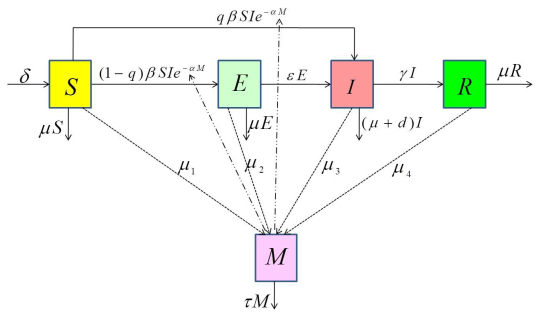









 DownLoad:
DownLoad:
